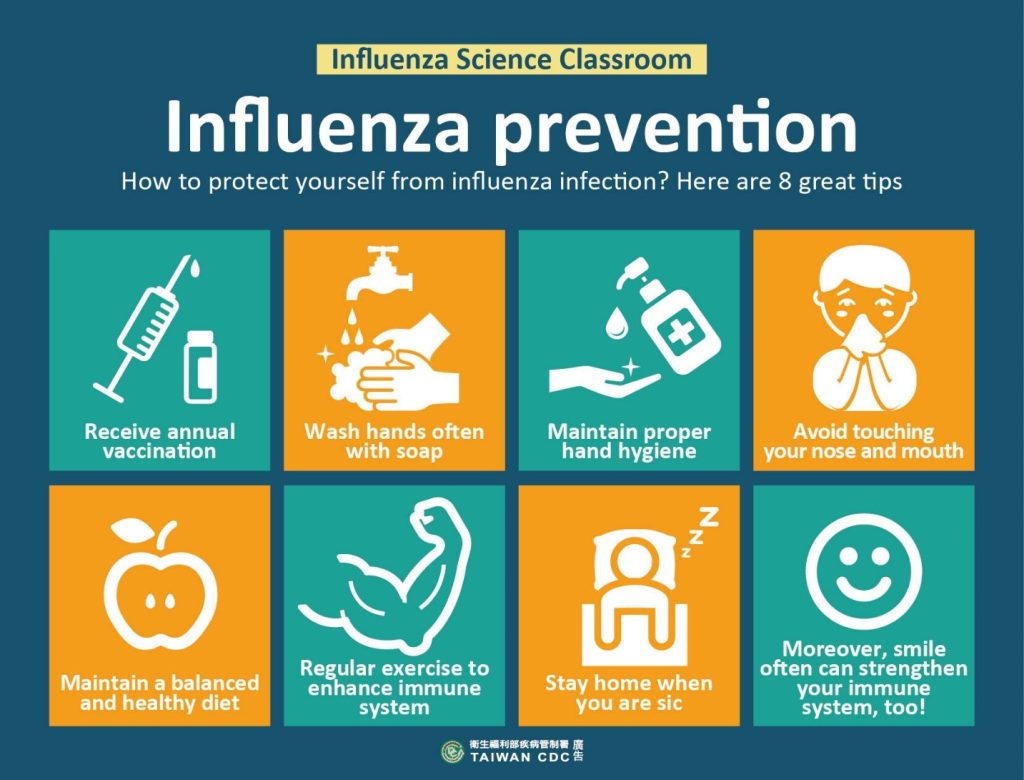Influenza

Introduction
Influenza, also known as flu is classified into seasonal influenza, avian influenza and pandemic influenza. The influenza A outbreak in Malaysia is classified as seasonal influenza. Avian influenza occurs mainly in birds and poultry (chicken and ducks) and usually do not infect other species but if virus get mutated, there will be a possibility for human to get infected. Meanwhile, pandemic influenza occurs once every 10-50 years when an animal influenza virus (avian influenza) undergoes major genetic changes and develops into a new influenza virus that will be transmitted among human, leading to a pandemic.
Seasonal influenza that affects human can be divided into:
- Type A
- Type B
Influenza A viruses are caused by RNA viruses belonging to the Orthomyxoviridae family, which is categorized into subtypes based on the types of 2 proteins on the surface if the viral envelope:
- H= hemagglutinin is a protein that causes red blood cells to agglutinate.
- N= neuraminidase is an enzyme that cleaves the glycosidic bonds of the monosaccharide sialic acid.
Avian influenza is also known as the bird flu, caused by type A strain (H5N1) of the influenza viruses. Influenza A is a subtype of the type A influenza viruses. It can be found in many species, including humans, birds, horses, and pigs, due to the breadth of potential hosts and its ability to genetically change over a short period of times, influenza A viruses are every diverse. Normally, its capable of causing a pandemic.
Unlike influenza A viruses, type B influenza viruses are only found in human. Influenza B viruses are further classified into two lineages: B/Yamagata and B/Victoria and will not cause pandemics. Influenza B virus may cause lesser reaction than influenza A virus, but it is still extremely harmful.
Transmission
Normally, airborne transmission occurs particularly in crowded enclosed spaces, from direct contact with droplets circulated by unprotected coughs and sneezes and contamination of the hands.
Risk group
- Pregnant women
- Children under 5 years old
- Elderly above 65 years old
- Patient with chronic disease (asthma, diabetic, heart and lung illness)
- Immunocompromised patient (HIV, cancer, chemotherapy patient or with steroid treatment)
- Obese
Incubation period:
The seasonal influenza that occurs yearly is type A and B with an incubation period of 1-4 days.
Sign & Symptoms:
Once the symptoms begin, one will experience high fever for 2-3 days. Influenza symptoms can range from mild to severe and they vary person to person:
- High fever
- Chest discomfort
- Cough
- Shortness of breath
- Sore throat
- Muscle pain
- Headache
- Sneezing
- Tiredness and fatigue
- Loss of consciousness
- Diarrhea and vomit
Complication:
High risk populations may develop complications:
- Pneumonia (lung infection)
- Encephalitis (brain infection)
- Heart diseases
- Rhabdomyolysis (Inflammation of muscle tissue)

Treatment:
Home remedies:
- Drink plenty of water
- Maintain a balanced diet
- Get enough of rest
- Avoid stress as it can weaken the body immune system
- Medications such as paracetamol or ibuprofen to treat fever or muscle pain
- Medications such as expectorants or mucolytics to treat cough and cold
Medication:
For Influenza A
- Antiviral medication is available by prescription only. It can shorten the duration of symptoms or prevent complications such as pneumonia. Antiviral medications such as Tamiflu (oseltamivir) or Relenza (zanamivir) can be started within 1-2 days of onset of influenza A symptoms and given around 3-5 days. Antibiotic are not effective against influenza virus at all.
Prevention:
Vaccine:
The World Health Organization (WHO) recognizes vaccination as one most effective way to prevent the influenza. Influenza vaccination provides protection for children and adults from different virus strains and help to reduce the disease transmission and complication. Vaccination takes 2 weeks to become fully effective for protection to develop after immunization and can last up to 1 year.
Precaution:
- Cover mouth and nose with tissue or handkerchief when sneezing or coughing
- Frequent hand wash with soap
- Wear a facemask while infect with influenza
- Avoid being in public places when having influenza

Reference:
- https://www.who.int/news-room/fact-sheets/detail/influenza-(seasonal)
- http://www.myhealth.gov.my/en/influenza-2/
- https://www.healthline.com/health/cold-flu/influenza-a-vs-b
- https://www.medicalnewstoday.com/articles/326672
- https://www.homage.com.my/health/influenza/
- https://specialty.mims.com/influenza/treatment?channel=respirology




